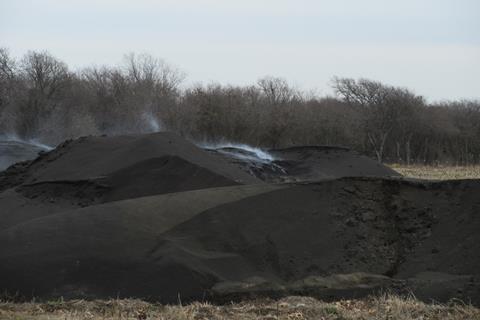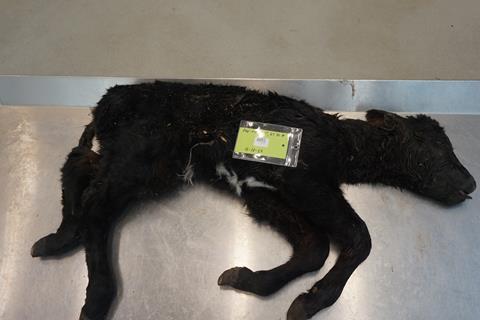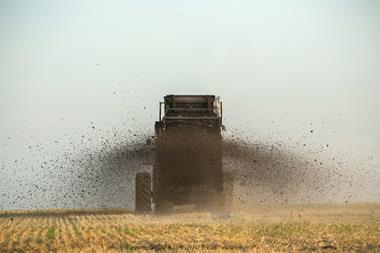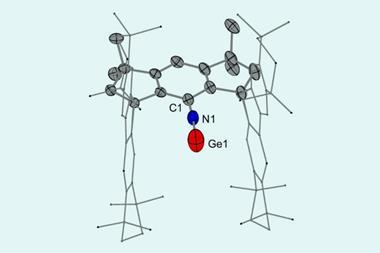The mystery of why farmers had started falling ill in Johnson County, Texas and what killed the fish in their ponds and livestock on their ranches may have been solved. The culprit is claimed to be a fertiliser contaminated with dangerous levels of polyfluoroalkyl and perfluoroalkyl substances (PFAS) that was spread on adjacent farmland, according to the findings of an ongoing criminal investigation.
The case began in late December 2022 when Dana Ames, an environmental crimes investigator for Johnson County, received a complaint from a farmer who said a neighbour was spreading what appeared to be fertiliser that had been smoking for days. He reported that the valley surrounding his property had filled up with smoke, which was creating breathing problems for himself, his wife and neighbours. Further, the farmer alleged that previous spreading of this material by the same neighbour had caused the fish in his pond and other nearby ponds to die and that it had led to his animals becoming ill too.
When Ames arrived on the scene, she observed a dozen or more large, black smouldering piles emitting large plumes of smoke with a smell so pungent that Ames recalls almost vomiting. She reported that the smoke also made it hard for her to breathe. Although it is unclear why the product was smoking, Ames says there are ‘a couple of different theories’ having to do with microplastics and composting.

Ames observed the product being spread by tractor and quickly discovered that it was a Synagro fertiliser made from biosolids – municipal wastewater-treated sewage sludge from the city of Fort Worth, Texas. She immediately opened an investigation and began collecting samples of soil, pond water, well water, as well as fish and animal tissue, for analysis. The Synagro fertiliser itself was also tested.
Synagro has denied that its fertilisers have harmed the health of farmers or livestock and is contesting the lawsuit.
In a statement, the firm said: ‘None of the plaintiffs themselves used Synagro products and the biosolids applied by a farmer working with Synagro met all [US Environmental Protection Agency] and Texas Commission on Environmental Quality requirements. US EPA continues to support land application of biosolids as a valuable practice that recycles nutrients to farmland and has not suggested that any changes in biosolids management is required.’
‘As a matter of fact, without any response from Synagro, the plaintiffs amended the complaint to drastically reduce the concentrations of PFAS alleged in the complaint when it was originally filed,’ the company added.
In the two years since the investigation began, Johnson County Commissioner Larry Woolley, a lifelong farmer and rancher with a degree in agriculture, cites reports of hundreds of fish and about 35 cattle and five horses dying that were blamed on PFAS-contaminated biosolids.
Since 2016, more than 866,000 tonnes of sewage sludge has been applied to US farmland, according to an analysis by the Environmental Working Group. The organisation estimates that 5% of all arable land in the US has had fertiliser applied to it that contains PFAS-contaminated biosolids. A recent draft report from the EPA appears to show that high levels of PFAS in sewage sludge applied to farmland can cause cancer and other diseases in those living near farms where it is applied.
PFOS in stillborn calf
Overall, 32 individual PFAS chemicals were identified on the victims’ properties, including perfluorooctanesulfonic acid (PFOS), perfluorooctanoic acid (PFOA) and hexafluoropropylene oxide-dimer acid (HFPO-DA), also known as GenX.
The PFAS accumulates in larger and larger amounts from soil to vegetation to animals
Kyla Bennett, Public Employees for Environmental Responsibility
PFAS levels in drinking water wells on the plaintiffs’ properties were found to range from 91 nanograms per litre (ng/l) up to 268ng/l and their soils ranged from 97ng/l to about 6291ng/l (1ng/l is equivalent to 1 part per trillion).
Some of the fish and animal tissue results were much higher. A stillborn calf had PFAS levels approaching 1500ng/l and its liver held more than 613,000ng/l of PFAS, the vast majority of which was PFOS. The tissue of another calf that died at a week old held 3200ng/l of PFAS, including 320ng/l of PFOS, though its liver was not tested.

Meanwhile, two fish tested at more than 74,000ng/l and 57,000ng/l of PFOS, respectively. And the actual fertiliser product itself tested at 13,000ng/l of PFOS in about 100g of the product. The source of the PFAS contaminating these biosolids isn’t entirely clear, but it is likely to be from runoff entering drains. This wastewater could be contaminated by PFAS-containing firefighting foams, industrial effluent, landfill leachate and other unknown sources.
Earlier this year, the EPA released long-awaited regulations that set national and enforceable drinking water standards for six PFAS, known as maximum contaminant levels (MCLs), which specified 4ng/l for both PFOA and for PFOS individually, as well as 10ng/l for GenX. The agency also proposed health-based, non-enforceable MCL goals of zero for PFOA and PFOS because ‘there is no dose below which either chemical is considered safe’.
Those thresholds are dramatically lower than the non-regulatory 70ng/l lifetime health advisory for drinking water that the EPA established in 2016 for PFOA and PFOS.
Biomagnifying up the food chain
Kyla Bennett, an ecologist who directs science policy for the nonprofit group Public Employees for Environmental Responsibility (Peer) and served as a consultant for the investigation, had previously been involved in a couple of cases involving biosolids and quickly connected the dots. ‘When we heard “biosolids”, we were like, “Well, we know what’s killing all of their animals”,’ recalls Bennett, a former wetland permit reviewer and wetlands enforcement coordinator at the EPA.
If we’re regulating drinking water to 4[ng/l] then biosolids should be regulated
Larry Woolley, County Commissioner
The PFAS contained in the biosolids can seep into the soil, groundwater and surface waters of land treated with this fertiliser. This can contaminate plants grown there, which are then eaten by livestock with the contamination moving up the food chain to people.
‘What we think is happening is that all this PFAS leached onto the neighbouring farm – to our clients,’ Bennett tells Chemistry World. ‘It got into the water – into the stock ponds – and the cows are drinking and swimming in those stock ponds and eating the grass, which is now contaminated with PFAS, and it biomagnifies through the food chain.’
‘The PFAS accumulates in larger and larger amounts from soil to vegetation to animals,’ she explains, noting that her affected clients have stopped selling their meat since they discovered the contamination.
Besides the criminal investigation that Ames is leading, there are two other related legal cases running in parallel.
Parallel lawsuits
The first involves Peer suing the EPA to force the agency to start regulating PFAS in biosolids under the Clean Water Act (CWA), which would involve prohibiting products from being applied to land if they contain PFAS in amounts above a certain threshold. The agency moved to dismiss that lawsuit back in September, arguing that the CWA only requires that it review biosolids regulations every two years but not actually identify ‘additional toxic pollutants’ to be regulated.
The other ongoing case is a liability lawsuit, launched by affected farmers, against Synagro and its Texas affiliate and brought by a private law firm. It seeks financial compensation for the plaintiffs – compensatory and punitive damages of more than $75,000.
‘Similar instances of PFAS poisonings of farms, dairies and ranches have occurred in several states,’ Bennett stated when announcing that lawsuit in February. She pointed out that Maine outlawed application of biosolids back in April 2022 after more than 60 farms were found to have unsafe levels of PFAS contamination. ‘This lawsuit against Synagro will likely be the first of many,’ Bennett predicted.
Michigan and Colorado have also put in place regulations requiring their wastewater treatment plants to assess and report the levels of PFAS contamination and control the entry of these chemicals into the wastewater system from major industrial sources.
States are stepping up in the absence of federal action. The EPA has no authority to regulate contaminants like PFAS in biosolids and it currently only requires that they be tested for nine heavy metals and a handful of pathogens.
EPA taking ‘far too long’
There is a consensus among many stakeholders about the importance of federal regulation of PFAS in biosolids. ‘If we’re regulating drinking water to 4[ng/l] then biosolids should be regulated at probably not 4[ng/l], but at some figure not much higher than that,’ Woolley states.
Ames agrees. ‘When the EPA says that these chemicals are so dangerous that we can’t afford to have more than 4[ng/l] in drinking water … can you tell me how in the hell it would be okay to sit down and eat a calf’s liver … that has 610,000[ng/l] of PFOS in it?’ she asks.
Before they started being applied as fertiliser, biosolids were disposed of in lakes, streams and oceans, contaminating waterways and marine life. Then the CWA, which became law in 1972, allowed application of this organic matter to farmland.
The EPA has been investigating whether PFAS should be regulated in biosolids for several years now and the agency is taking ‘far too long’ to act, according to Bennett. ‘We’re losing farms all across the country,’ she says. ‘If you look at Maine, they have something like 70-plus impacted farms, and Michigan, Minnesota, New Mexico – everywhere you look – we’re finding problems.’
PFAS is ubiquitous in consumer products and these chemicals are not removed during wastewater treatment. In fact, up to 19 times more PFAS are created during this process because some of these chemicals get partially broken down and then recombine and form new PFAS compounds, according to Bennett.
Currently, there are three EPA-approved methods for disposing of biosolids – incineration, landfill and applying them to land. The cheapest option is to sell such products as fertiliser to farmers for anywhere from $30–$40/tonne, Woolley notes.
Meanwhile, the EPA still has no standard definition of PFAS. Bennett argues that the agency should define these chemicals broadly, regulate them as one class, and ban all non-essential uses. ‘If they do those three very simple things, then there won’t be PFAS in our consumer products and it won’t be in the biosolids, and then they can land apply it,’ she states.
Legislating for PFAS
In terms of what’s next for Johnson County, the legislative session starts in late January, and one of Woolley’s goals is to educate county leaders, as well as state representatives and state senators, about the risk of PFAS-contaminated biosolids in fertiliser. He and fellow commissioners are currently working on developing draft legislation to address the issue.
This is a national crisis that is threatening our entire food supply
Kyla Bennett, Public Employees for Environmental Responsibility
At the state level, Texas state congresswoman-elect Helen Kerwin introduced legislation on 19 December to strictly limit the amount of PFAS chemicals in fertilisers and other agricultural materials. This bill would also require manufacturers to regularly test for, and publicly report, PFAS levels.
There is concern about progress at the national level in the US. Bennett, for example, is not optimistic about the new administration, noting that Project 2025 – a conservative blueprint for a second Trump presidency that was crafted with input from several of the president-elect’s former cabinet members – clearly expresses an intent to revisit PFAS regulations and the designation of these chemicals as ‘hazardous substances’.
The Republican senator who will chair the Senate Environment and Public Works Committee in the new Congress, Shelley Moore Capito, recently repeated claims that the EPA’s new, stricter PFAS drinking water standards are based on questionable science and she suggested that these regulations are too costly for water utilities to implement.
Water utilities and chemical companies are already challenging these rules in court, with the former arguing that they significantly underestimate nationwide compliance costs, and the latter maintaining that the regulations exceed the agency’s authority.
‘The EPA is being sued over the MCLs, and under a Trump EPA I can see them saying, “Yep, you’re right, never mind, we’ll revisit this”,’ Bennett states. She notes that these drinking water standards aren’t even in effect because the EPA gave public water systems five years – until 2029 – to comply.
PFAS-contaminated biosolids in fertilisers is not just a Johnson County or Texas problem, Bennett emphasises. ‘This is a national crisis that is threatening our entire food supply,’ she warns. ‘We cannot afford to have a state-by-state solution to this problem – we need a federal solution.’

















2 readers' comments